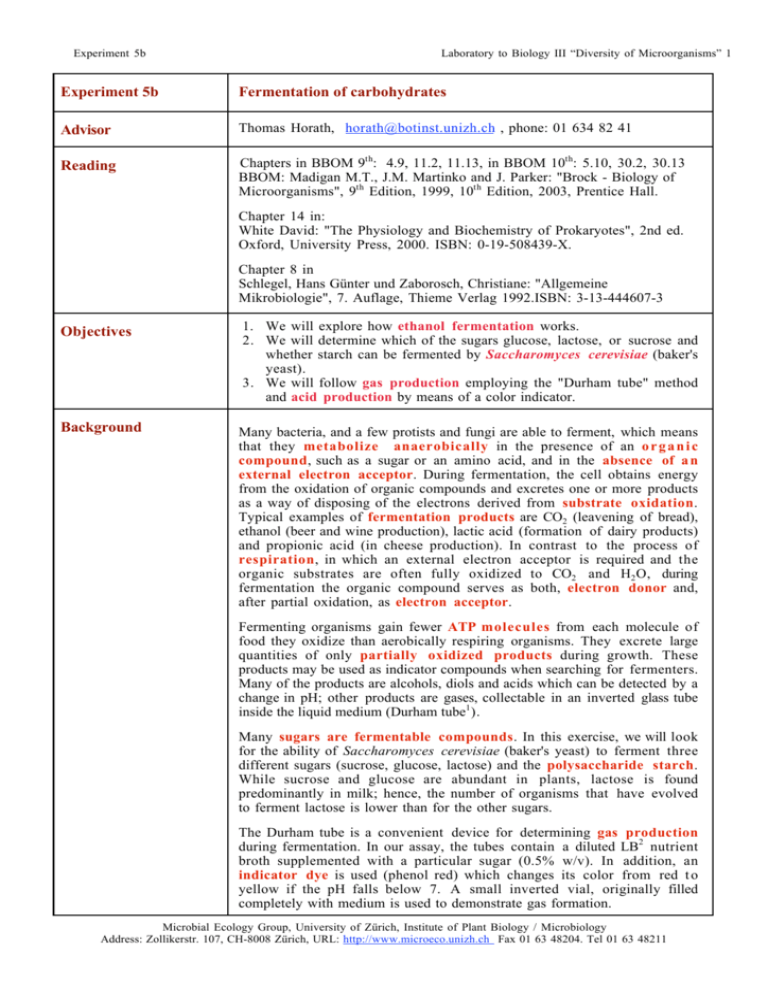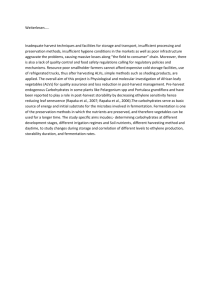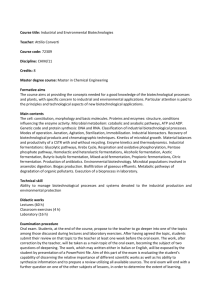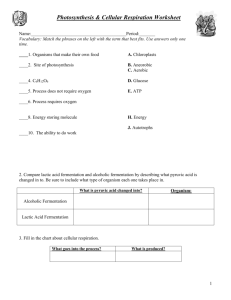Experiment 5b Fermentation of carbohydrates Advisor
advertisement

Experiment 5b Laboratory to Biology III “Diversity of Microorganisms” 1 Experiment 5b Fermentation of carbohydrates Advisor Thomas Horath, horath@botinst.unizh.ch , phone: 01 634 82 41 Reading Chapters in BBOM 9th: 4.9, 11.2, 11.13, in BBOM 10th: 5.10, 30.2, 30.13 BBOM: Madigan M.T., J.M. Martinko and J. Parker: "Brock - Biology of Microorganisms", 9th Edition, 1999, 10th Edition, 2003, Prentice Hall. Chapter 14 in: White David: "The Physiology and Biochemistry of Prokaryotes", 2nd ed. Oxford, University Press, 2000. ISBN: 0-19-508439-X. Chapter 8 in Schlegel, Hans Günter und Zaborosch, Christiane: "Allgemeine Mikrobiologie", 7. Auflage, Thieme Verlag 1992.ISBN: 3-13-444607-3 Objectives 1. We will explore how ethanol fermentation works. 2. We will determine which of the sugars glucose, lactose, or sucrose and whether starch can be fermented by Saccharomyces cerevisiae (baker's yeast). 3. We will follow gas production employing the "Durham tube" method and acid production by means of a color indicator. Background Many bacteria, and a few protists and fungi are able to ferment, which means that they metabolize anaerobically in the presence of an o r g a n i c compound, such as a sugar or an amino acid, and in the absence of a n external electron acceptor. During fermentation, the cell obtains energy from the oxidation of organic compounds and excretes one or more products as a way of disposing of the electrons derived from substrate oxidation. Typical examples of fermentation products are CO2 (leavening of bread), ethanol (beer and wine production), lactic acid (formation of dairy products) and propionic acid (in cheese production). In contrast to the process of respiration, in which an external electron acceptor is required and the organic substrates are often fully oxidized to CO2 and H2 O, during fermentation the organic compound serves as both, electron donor and, after partial oxidation, as electron acceptor. Fermenting organisms gain fewer ATP molecules from each molecule of food they oxidize than aerobically respiring organisms. They excrete large quantities of only partially oxidized products during growth. These products may be used as indicator compounds when searching for fermenters. Many of the products are alcohols, diols and acids which can be detected by a change in pH; other products are gases, collectable in an inverted glass tube inside the liquid medium (Durham tube1 ). Many sugars are fermentable compounds. In this exercise, we will look for the ability of Saccharomyces cerevisiae (baker's yeast) to ferment three different sugars (sucrose, glucose, lactose) and the polysaccharide starch. While sucrose and glucose are abundant in plants, lactose is found predominantly in milk; hence, the number of organisms that have evolved to ferment lactose is lower than for the other sugars. The Durham tube is a convenient device for determining gas production during fermentation. In our assay, the tubes contain a diluted LB2 nutrient broth supplemented with a particular sugar (0.5% w/v). In addition, an indicator dye is used (phenol red) which changes its color from red t o yellow if the pH falls below 7. A small inverted vial, originally filled completely with medium is used to demonstrate gas formation. Microbial Ecology Group, University of Zürich, Institute of Plant Biology / Microbiology Address: Zollikerstr. 107, CH-8008 Zürich, URL: http://www.microeco.unizh.ch Fax 01 63 48204. Tel 01 63 48211 Experiment 5b Laboratory to Biology III “Diversity of Microorganisms” 2 Remark: Since there are other nutrients present, a number of organisms will grow even if they cannot ferment sugar. Nevertheless, only an organism able to ferment the sugar efficiently will produce larger amounts of alcohols, acid and/or gas. No special precautions are needed in this experiment to exclude air. O2 is poorly soluble in H2 O, and it will be used up quickly as organisms begin to grow. Once micro-oxic or anoxic conditions have been established, fermentation will predominate. Recording the results of fermentation tests on a daily basis for the first 2-3 days of growth yields results of maximum validity. After fermentative growth has ceased, O2 might slowly diffuse into the medium, allowing further oxidative metabolism of the fermentation products. If these are acids, they may be oxidized to CO2 and H2 O, causing the indicator dye to change back from yellow to red (alkaline reversion). Slow deamination of amino acids, for example, produces ammonia (NH3 , basic) which can contribute to alkaline reversion as well, and to pH increases indicated by a deep red color of the indicator dye, even in the absence of sugar fermentation. (Fermentation will be discussed in more detail in the Microbial Metabolomic course, 4 th semester) Literature www. Links Material Leboffe, M.J. and B.E. Pierce. 1999. A Photographic Atlas for the Microbiology Laboratory, 2n d ed. Morton Publishing Co. Englewood, CO. http://medic.med.uth.tmc.edu/path/00001458.htm http://www.wildfermentation.com/ Material needed for each student: • 6 culture Durham1 tubes containing 9.8ml diluted LB-medium2 (LB 1 /1 0 0 x) and about 0.2 ml of 0.04% (w/v) aqueous phenol red solution (phenolred sodium salt, Fluka 77665) in tube rack • 2 Eppendorf pipettes (1 ml and 0.1 ml) Available: • boxes with blue and yellow Eppendorf pipette tips • Suspension culture of Saccharomyces cerevisiae (baker's yeast) in tube • consortium of unknown bacterial strains: enrichment obtained from a compost heap • Lactic acid bacterial consortium from yoghurt • 11 x concentrated sucrose stock solution (5.5% (w/v): 5.5 g/100 ml) • 11 x concentrated lactose stock solution (5.5% (w/v): 5.5 g/100 ml) • 11 x concentrated glucose stock solution (5.5% (w/v): 5.5 g/100 ml) • 11 x concentrated starch stock solution (5.5% (w/v): 5.5 g/100 ml) • vortex mixer • 32°C incubator 1 The Durham tube: A tube containing supplemented nutrient broth (in our assays 1 /1 0 0x LB + carbohydrate), phenol red, and a small inverted vial filled completely with medium. 2 LB-Medium ("Luria Bertani broth") amounts are given in g per liter medium. LB (1x) LB (1 /1 0 0 x) tryptone yeast extract NaCl 1M NaOH 10 g/l 5 g/l 5 g/l 1 ml/l (→ pH 7) 0.1 g/l 0.05 g/l 5 g/l ? (→ pH 7) LB solid medium: 15 g agar per liter of liquid medium. Microbial Ecology Group, University of Zürich, Institute of Plant Biology / Microbiology Address: Zollikerstr. 107, CH-8008 Zürich, URL: http://www.microeco.unizh.ch Fax 01 63 48204. Tel 01 63 48211 Experiment 5b Experimental Protocols Laboratory to Biology III “Diversity of Microorganisms” 3 Fermentation test: • Choose one of the inocula (Saccharomyces cerevisiae, compost enrichment or yoghurt) and inoculate into glucose, lactose, sucrose, and starch medium. Control: keep one tube of each medium without inoculum. • Incubate at 32°C. • Examine the tubes for growth after 2-3 days (one week for the starch culture). Growth is indicated by turbidity of the medium, cells sedimented at the bottom of the tube, or/and formation of a ring (pellicle) at the air-liquid interface. • Record the change in color of the tubes as follows: A banana yellow color indicates acid production; yellow-orange indicates production of slight acid; if there is no change in color (i.e. if the color is the same as that of the uninoculated control tube), it means that there was no more acid production than base production. If the color changes from the original red to a more magenta color, the alkalinity has increased. If the indicator turned colorless ("transparent") it means no acid was produced, and the organism used the indicator as a hydrogen or electron acceptor, reducing it to its colorless form. • Record the gas production as follows: A sizable bubble indicates gas production (+). A very tiny bubble does not indicate gas production by fermentation and can be recorded as "-". Gas produced by fermentation is always abundant and obvious. Remove the cap and sniff for odor. Is the odor familiar ? Record your observations. • Construct a table with your results. Continue incubating for a few more days. Then observe the tubes again. Did the color of any of the acid tubes revert from yellow to red or pink ? Record the changes. • Observe the microbial comunity under a microscope. tube No. 1 2 3 4 5 6 10 ml 10 ml 10 ml 10 ml 10 ml 10 ml sucrose 5.5% - 1 ml - - - - lactose 5.5% - - 1 ml - - - glucose 5.5% - - - 1 ml - - starch 5.5% - - - - 1 ml - LB (1%) + indicat. H2O 1 ml - - - - 1.1 ml inoculum * 0.1 ml 0.1 ml 0.1 ml 0.1 ml 0.1 ml - total volume 11.1 ml 11.1 ml 11.1 ml 11.1 ml 11.1 ml 11.1 ml 32°C 32°C 32°C 32°C 32°C 32°C incubation Results: gas color organisms later changes * choose - one of the following inocula: Saccharomyces cerevisiae compost enrichments yoghurt community Microbial Ecology Group, University of Zürich, Institute of Plant Biology / Microbiology Address: Zollikerstr. 107, CH-8008 Zürich, URL: http://www.microeco.unizh.ch Fax 01 63 48204. Tel 01 63 48211 Experiment 5b Laboratory to Biology III “Diversity of Microorganisms” 4 Laboratory Rules & Precautions Saccharomyces cerevisiae is a harmless organism. But since we do not know what kind of organisms will grow in the enrichments, we have to handle them cautiously. As a rule, autoclave all tubes and plastic ware that have been in contact with cultures. Wash your hands before leaving the laboratory. Experiences gained Handling microorganisms, learning about anaerobic organotrophic life styles Timing 1 hour Reporting Take notes on the experiment in your laboratory journal and describe the results in the report. Questions to be answered 1. How would you continue the experiment? 2. Try to write a stoichiometric equation which most closely describes the fermentation of one of the 4 substrates tested. 3. What is the difference between "substrate-level phosphorylation" and "electron transport phosphorylation"? 4. To what kind of pathway does glycolysis belong to: fermentation or respiration? 5. Which are the three best known fermentation products? 6. In addition to photosynthesis, what are the main pathways to regenerate ATP by organisms living on Earth? Observations Microbial Ecology Group, University of Zürich, Institute of Plant Biology / Microbiology Address: Zollikerstr. 107, CH-8008 Zürich, URL: http://www.microeco.unizh.ch Fax 01 63 48204. Tel 01 63 48211







